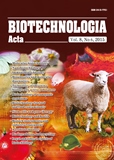ISSN 2410-7751 (Print)
ISSN 2410-776X (Online)

"Biotechnologia Acta" V. 8, No 6, 2015
https://doi.org./10.15407/biotech8.06.056
Р. 56-62, Bibliography 15, English
Universal Decimal Classification: 579:662.7
PROPERTIES OF NEW STRAINS CHEMOLITHOTROPHIC BACTERIA ISOLATED FROM INDUSTRIAL SUBSTRATES
I. A. Blayda1, T. V. Vasyleva1, V. I. Baranov2, K. I. Semenov1, L. I. Slysarenko, I. M. Barba1
1 Mechnykov Odesa National University, Ukraine
2 Franko Lviv National University, Ukraine
The purpose of the research was determination of strains Acidithiobacillus ferrooxidans MFLv37 and Acidithiobacillus ferrooxidans MFLad27, isolated from aboriginal consortium of coal beneficiation dumps and fly ash from coal combustion, resistance to heavy metals, forming part of these waste, as well as adaption ability of the strains to new substrates. New strains increased resistance to heavy metal ions as compared to A. ferrooxidans standard and collection strains is found; minimal inhibitory concentrations of heavy and toxic metals are determined; a number of metals that have negative impact on growth of isolated cultures are identified. It is shown that the minimal metals concentrations, at which strains growth still happens, are several times higher than their concentrations in technogenic waste. It has been established that isolated strains differed in their ability to adapt, as well as in growth rate and substrates oxidation. This is due to the specific conditions of microbiocenoses formation in making and further storage of rock dumps and fly ash, whereof the appropriate strains are isolated. The investigations indicate the necessity in directional selection of strains that are resistant to the toxic compounds and are able to oxidize various mineral substrates, as well as in their adaptation to new substrates for the extraction of heavy metals.
Key words: fly ash, rock dumps, aboriginal bacterial community, acidophilic chemolithotrophic bacteria, strains, leaching activity, ions of heavy metals.
© Palladin Institute of Biochemistry of the National Academy of Sciences of Ukraine, 2015
References
1. Ivanov M. V., Karavayko G. I. Geological microbiology. Mikrobiologiya. 2004, 5 (73), 581–597. (In Russian). http://dx.doi.org/10.1023/b:mici.0000044241.17848.38
2. Norris P. R., Burton N. P., Foulis N. A. M. Acidophiles in bioreactor mineral processing. Extremophiles. 2000, V. 4, P. 71–76. http://dx.doi.org/10.1007/s007920050139
3. Blayda I. A. Extraction of valuable metals from industrial waste biotechnological methods (Review). Energotekhnologii i resursosberezhenie. 2010, V. 6, P. 39–45. (In Russian).
4. Blayda I. A., Vasileva T. V., Slyusarenko L. I., Barba I. N., Ivanitca V. A. Composition and leaching activity of energy industrial waste microbiocenosis. Problemy ekolohіchnoі bіotekhnolohіi. 2013, V. 1. Available at: http://jrnl.nau.edu.ua /index.php/ecobiotech/article/view/4592. (In Russian).
5. Blayda I. A. Composition and activity of bacterial community of coal tailing. Biotechnol. acta. 2014, 7 (5), 94–100. doi: 10.15407/biotech7.05.094. http://dx.doi.org/10.15407/biotech7.05.094
6. Tupikina O. V., Kondrateva T. F., Samorukova V. D., Rassulov V. A., Karavayko G. I. Dependence of the strains Acidithiobacillus ferrooxidans phenotypic characteristics from the physical, chemical and electrical properties of pyrites. Mikrobiologiya. 2005, 74 (5), 596–603. (In Russian).
7. Karavayko G. I., Kuznetsov S. I., Golomzik Ye. I. The Role of Microorganisms in the leaching of metals from ores. Moskva: Nauka. 1972, 248 p. (In Russian).
8. Silver M. Metabolic mechanisms of iron-oxidizing thiobacilli. Metallurgical applications of bacterial laeching and related microbiological phenomena. Murr L. E., Torma A. E., Brierley J. A. (Eds). New York: Academic Press. 1978, P. 3–17.
9. Grudev S. N. The differences between the strains of Thiobacillus ferrooxidans on the ability to oxidize sulfide minerals. Biogeotehnologija metallov. Karavayko G. I., Grudev S. N. (Red.). Moskva: Centr mezhdunarodnykh proektov GKNT. 1985, P. 85–99. (In Russian).
10. Tuovinen O. H., Fry I. J. Bioleaching and mineral biotechnology. Curr. Opin. Biotechnol. 1993, V. 4, P. 344–355. http://dx.doi.org/10.1016/0958-1669(93)90106-7
11. Juszczak A., Domka F., Kozlowski M., Wachowska H. Microbial desulfurization of coal with Тhiobacillus ferrooxidans bacteria. Fuel. 1994, 74 (5), 725–728.
12. Vasileva T. V. Diversity of the microorganisms community in the technogenic ecosystems of Ukraine fuel-and-energy complex. Problemy ekolohіchnoi bіotekhnolohіi. 2014, V. 1. Available at: http://ecobio.nau.edu.ua /index.php/ecobiotech/article/view /6660. (In Ukrainian).
13. Khmelev I. A. Plasmids and evolution of microorganisms. Uspekhi sovremennoy biologii. 1985, 99 (3), 323–337. (In Russian).
14. Kenji Iwahorl, Fumiaki Takeuchi, Kazuo Kamimura, Tsuyoshi Sugio. Ferrorous Iron-Dependent Volatilization of Mercuri by the Plasma Membrane of Thiobacillus ferrooxidans. Apll. Envir. Microbiol. 2000, P. 3823–3827.
15. Kondrateva T. F., Ageeva S. N., Pivovarova T. A., Karavayko G. I. Characteristics of chromosomal DNA restriction profiles strains Acidithiobacillus ferrooxidans, adapted to different substrates oxidation. Mikrobiologiya. 2002, 71 (4), 514–520. (In Russian).

